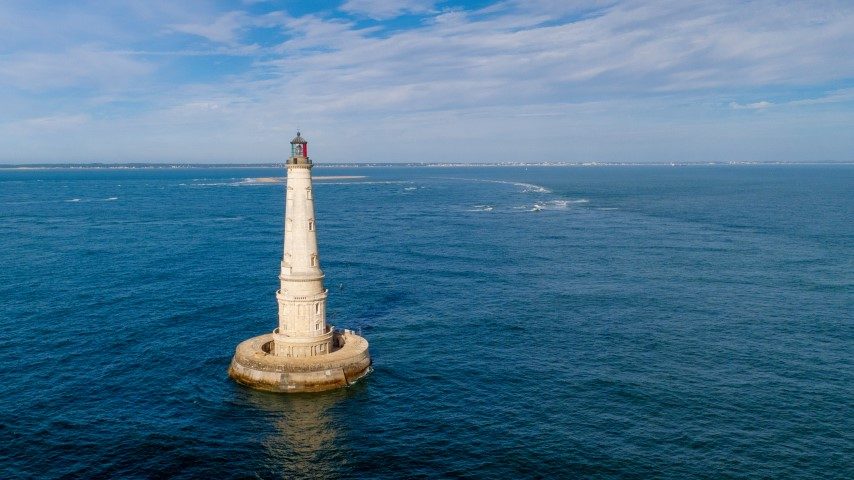

In 1823 a humble French physicist – playing around with glass prisms – discovered a way to boost the intensity of a single light. It led to a revolution in lighthouses – their warning winks could be seen from much further away – making for safer coastal navigation. Words by Lawrence Schaffler. Photography supplied.
The physicist was Augustin Fresnel – and the best way to appreciate the brilliance of his invention is to visit the magnificent 500-year-old Phare de Cordouan lighthouse on France’s west coast, near the mouth of the Gironde estuary, about 100km north of Bordeaux.

While it’s an architectural and historical marvel in its own right (it’s currently being considered for UNESCO Heritage Site status), its place in history was assured because it became the world’s first lighthouse to receive Fresnel’s invention, and the display within tells his story in fascinating detail.
His discovery is particularly remarkable because it happened in an era when relatively little was known about the behaviour of light. While 19th century scientists were familiar with the theory of light as posited by 17th century Dutch physicist Christiaan Huygens (he suggested – correctly – that light travelled in the form of waves), it remained a theory.
Fresnel discovered that by arranging a series of small, convex prisms into the shape of a beehive, he could re-capture the light (in those days provided by a flame) – and intensify it. His ground-breaking invention was based on ‘optical geometry’ and thereafter became known as the ‘Fresnel lens’.
When light passes between mediums of different densities – from air to glass or glass to water, for example – it’s refracted
(bent) and continues through the new medium in a slightly different direction. His concentric arrangement of the prisms captured and ‘amplified’ the light, making it visible over much greater distances.
Fresnel installed his prototype at the Cordouan lighthouse in 1823 – and within half a century this optical wizardry had been fitted to hundreds of lighthouses all over the world. For 19th century sailors without the benefits of RDF, GPS or even accurate charts, navigating around treacherous coasts became a lot safer.
Architectural Gem
But Cordouan is much more than a salute to Fresnel. Often described as a Renaissance masterpiece, it is many things in one structure – a lighthouse, a chapel, a fort and a royal palace – and arguably one of the world’s most beautiful lighthouses. It is France’s oldest operating lighthouse (construction began in the 16th century) and the world’s first to be built in the open sea (it stands on a tidal reef).
It is also one of the world’s few lighthouses that’s still manned permanently, and its custodians like to refer to it as the ‘Versailles of the Sea’. It’s easy to see why – its design harks back to an era of privileged extravagance. It also reflects Europe’s turbulent religious/political tensions over the centuries, and that entire saga is colourfully documented within the lighthouse.

It all began in the 14th century. The mouth of the estuary was renowned for its danger – scores of shipwrecks gave it an infamous nickname: the sailors’ graveyard. So in about 1360 the Black Prince (Edward, Prince of Wales), then commander of the English armies occupying Guyenne, ordered the building of a beacon to secure the mouth of the Gironde. This ‘Tour aux Anglais’ (the English tower) was a 16m structure topped by a platform where, every night, a hermit would keep a wood fire going.
Though rudimentary at best, it lasted nearly 200 years. In 1584, Henry III commissioned architect Louis de Foix to rebuild the old tower. Reflecting Henry’s view of the world (and of himself), the contract specified a ‘royal work’, fit for a king. Convoluted religious wars – with their attendant financial problems – kept progress to a snail’s pace. Still, de Foix persevered, even after the king’s death.

By 1594, under Henry IV, the lighthouse began to resemble the royal vision. For what was ostensibly a practical structure it was remarkably exotic – it featured marble, carved wood panelling, paintings and sculptures, gilt trim, ornate pediments, small alcoves and domed ceilings and black-and-white mosaic tiles. Given the monarchy’s Catholicism, Cordouan would go on to become the only lighthouse ever to have its own chapel. Ironically, no monarch ever actually used the edifice.
It was finally completed in 1611. De Foix died c1603 and never saw the finished structure. But at the time his 37m lighthouse was considered “the Eighth Wonder of the World”. It’s light (fire) was provided by a mixture of tar, pitch and wood. Over the centuries the fuel source switched to whale oil, coal, rapeseed oil and, much later, to gas.

In 1786 Joseph Teulère, a Bordeaux architect, was commissioned to raise the height of the lighthouse by 20m – the result was the lighthouse we see today. Teulère introduced a number of progressive changes, including a counterweight driving a rotary mechanism to create an ‘occulting’ beam – successive flashes of light. The concept was derived from a 1780 Swedish clock-making invention. Cordouan was one of the world’s first lighthouses to adopt this technology.
But the 1789 French Revolution removed the glitz. Royalty and its trappings were no longer tolerated. All royal effigies and inscriptions – along with the heads of the monarchy – were removed. Despite these egalitarian changes, there are still plenty of reminders reflecting Cordouan’s gilded past. Not quite Versailles, but not bad for a lighthouse.

The lighthouse was finally electrified in 1948, with two generators powering a 6,000-watt bulb. Automation and computerisation arrived in 2006.
For lighthouse spotters (yes, they do exist), Cordouan is only accessible by a boat leaving from the mainland, and then only between April and November. After a 301-step climb – and risk of a cardiac arrest – visitors are greeted by a glorious panoramic view, albeit one that belies the coast’s deadly history.




